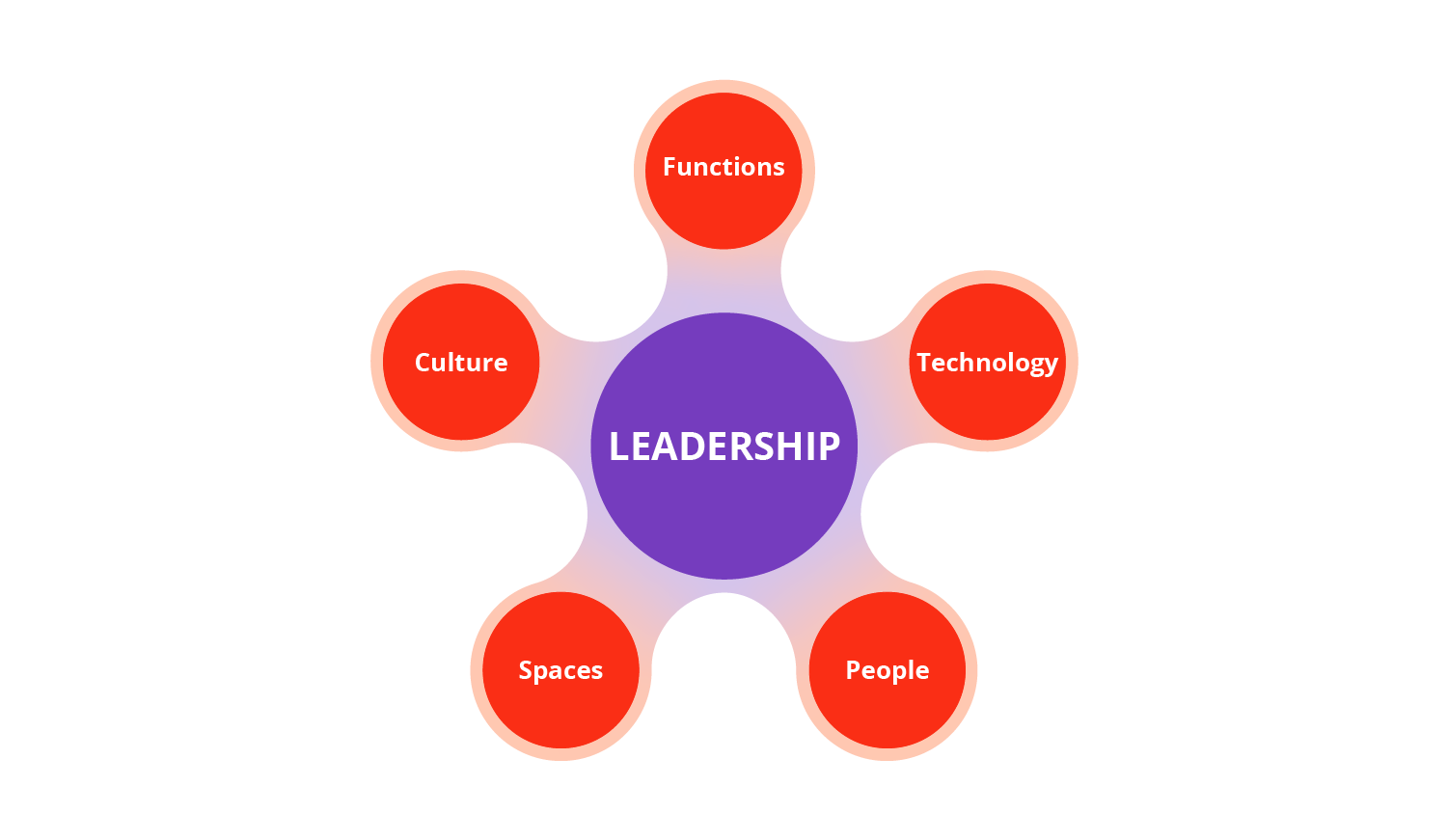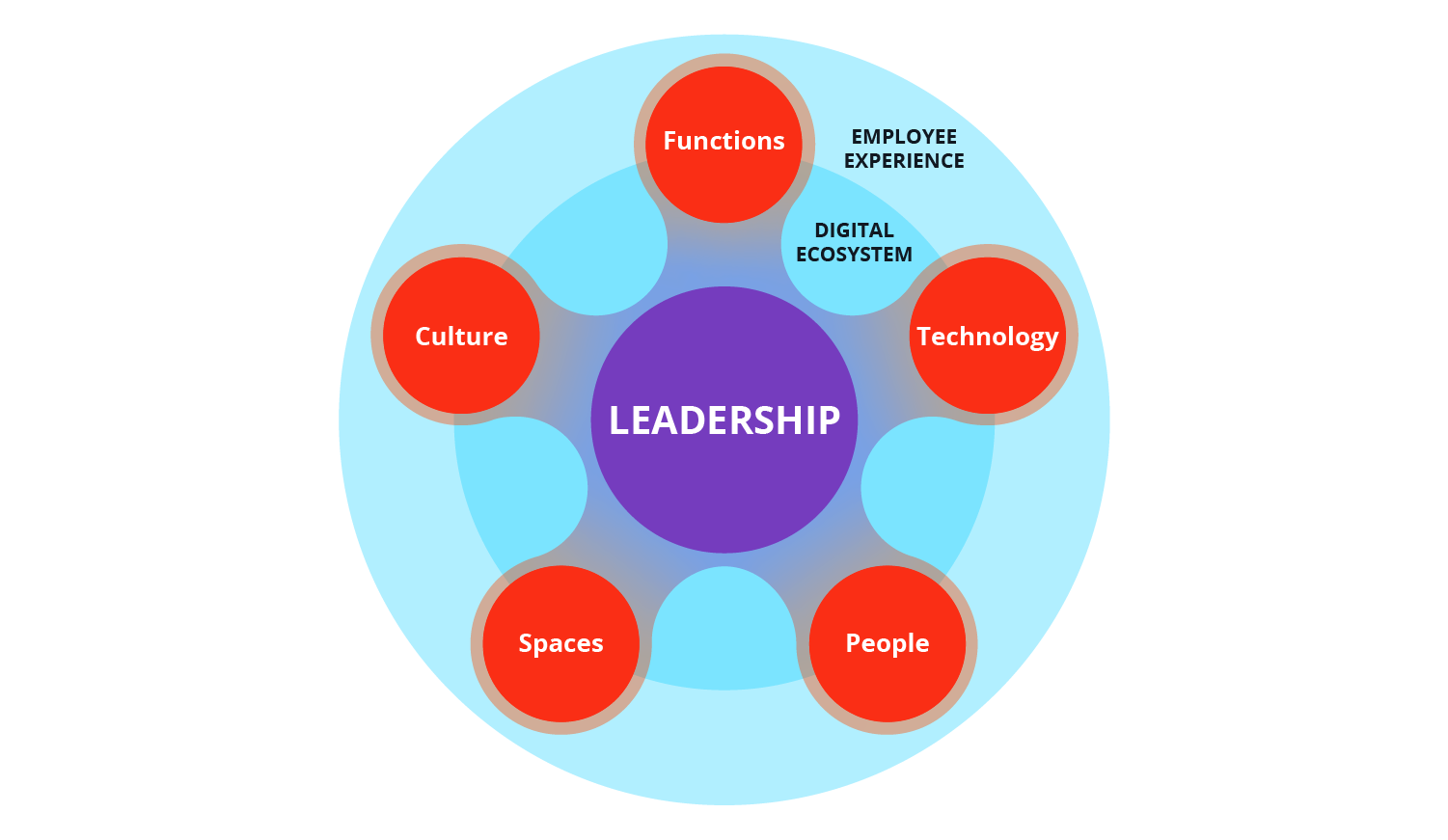Organizational leadership in uncertain times
Which practices guide us when the spaces and traditional structures of our working routines are missing?
The COVID-19 pandemic has generated a process of organizational change. As we stated before (link), this collective experience could drive change across all five main organizational areas: people, functions, technology, spaces and culture.
One of the first and more impacting consequences of the COVID-19 pandemic spread has been the elimination of the physical spaces and daily behaviors that we associate with our jobs.
Reduced physical interactions between employees is not only one of the most noticeable constraints on business-as-usual, it is maybe one of the most impacting one from the organizational perspective affecting profoundly all the dimensions we take into consideration and, ultimately, impacting on the leadership structure.
The five key organizational areas

Sharing the workload, organizing teams, ensuring that everybody has the proper conditions to work, understanding the general dynamics of the workplace in times of uncertainty have become cultural, functional, technological and organizational issues to manage for organizations and their leaders, making the lack of physical interaction a systemic issue impacting on traditional leadership patterns
As the World Economic Forum recently published (https://www.weforum.org/agenda/2020/05/leaders-should-use-their-vision-and-trust-to-create-a-new-and-better-normal/), there is a hidden opportunity in this situation: “As we move into the recover phase, resilient leaders will seize the opportunity to grow and change. Having built and integrated new attitudes, beliefs, agility and structures into their organizations’ DNA, they’ll not just recover lost ground, but catapult forward, quickly”.
To fully seize the moment, leaders should act now to detect inside their organizations, new behaviors, tools and channels to connect with the workforce, guiding them through uncertainty by reimagining the structure of our working routines while at the same time protecting the essential feeling of the workplace.
Succeeding would mean being able to create a resilient & adaptive leadership, one that keeps its goals while changing its ways.
It is in fact an opportunity to reimagine the ways in which an organization thrive.
Adopting the right mindset to work towards these goals means accepting a scenario that don’t forecast a short- term recovery, but embrace change and seize its hidden potentials. Examples of this can be gathered from the organizational landscape and beyond.
In an attempt to rebalance the needs of a whole country, New Zealand Prime Minister Jacinda Ardern has suggested businesses could shift to a four-day working week to boost domestic tourism. By recognizing that the current situation enhances flexibility – and possibly productivity – at work, the government envisions an opportunity to improve its citizens work-life balance by creating a space to boost domestic travels and tourism, on which the country’s economy relies greatly.
At the same time, embracing the limits imposed by the lockdown, Twitter has become the first major tech company to allow employees who can work remotely to do so indefinitely. Allowing work-from-home to emerge as the new norm, the company’s leadership aims at integrating resiliency in its patterns. Limiting the office space will have an impact on the company’s economic performance, while adopting new behaviors will allow the workforce to reimagine their work-life balance for the better.
These cases show that organizational resiliency is imaginable, but they also show that leadership can succeed only when its enabled by trust. The routines and structures associated with the workplace must be replaced by something new, a kind of collaboration that is able to thrive at a distance. Trust is at the foundation of the kind of cooperative and collaborative leadership that can thrive in uncertain times, allowing to flatten hierarchies towards a more horizontal organizational structure, one that enables collaboration to thrive at a distance.
In practical terms, experimenting with a resilient leadership means enabling trust and horizontality. How can it be done?
- Understand how the employee experience is changing through uncertainty and new routines – through assessments, research and mapping of the employee journey, working on the functions’ and spaces dimensions.
- Empower all the workforce with the same tools and channels to be able to work in collaboration from a distance – through the implementation of a seamless digital ecosystem that provides all the tools and channels employees needs to work and connect with their peers – such as the Office 365 suite. Technical implementation alone would not be successful, if not supported by the right adoption plan, which needs to take into consideration the employees’ digital readiness and understanding of the collaboration dynamics. This means working on the cultural dimension, as well as on the technological one.
- Identify inside the organization those who can help in driving and support the change towards an upgraded employee experience – through an analysis of the organization’s dynamics such as the ONA, or organizational network analysis, which maps the flows of communication and information inside an organization. This analysis will allow to explore the last dimension to take into consideration, the one regarding people.
Enabling change in the five key organizational areas

The opportunity to change and move forward is real. As stated by the World Economic Forum (https://www.weforum.org/agenda/2020/05/workers-thrive-covid-19-skills/), “Our collective ability to operate successfully in a platform-based world will become much more important now because linear models – the most basic example of which is the factory assembly line – are not agile or resilient enough to withstand major disruptions like COVID-19. Such disruptions will become much more common in the decade ahead, so the importance of preparing our businesses, governments and institutions for this cannot be overstated.”

 5 June 2020
5 June 2020
